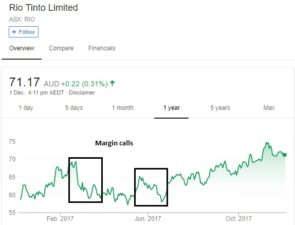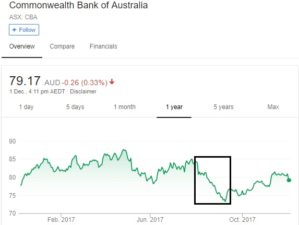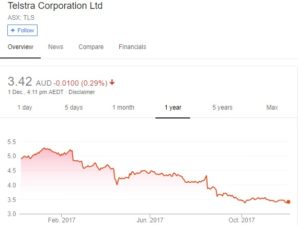Last week I wrote a brief piece on whether investors should borrow to invest in shares. If you do decide to invest in shares, especially using a margin loan, there are a number of red flags you should be looking for. Here are some of the biggest:
Share price volatility:
If you take out a margin loan with the maximum leverage possible, you should be wary of companies with volatile share prices. This includes miners, companies with significant debt, and companies with lower trading volume. If you have a margin loan and the price of your shares falls significantly, you can be placed into 'margin call' where you need to sell some of your shares or hand over extra cash to the bank to make up the losses you've sustained.
For illustration, if you took a margin loan out at the maximum loan to valuation ratio (LVR) of 70% and placed it in a single company – even the seemingly safest companies – you could have had a bad 2017:
Here's Rio Tinto Limited (ASX: RIO)

Here's Commonwealth Bank of Australia (ASX: CBA):

And of course, Telstra Corporation Ltd (ASX: TLS) has been nothing but a big margin call this year:

Readers can see how even the seemingly most reputable and 'safest' companies can become highly risky once a margin loan is involved. If you'd taken a margin loan at the start of the year and placed it into one of these 3 stocks, you could have easily lost a lot of money, depending on the price you paid for shares. The Motley Fool doesn't encourage borrowing to invest in stocks, but if you are going to do it, consider these strategies to reduce your risks:
- Diversify: Aim to hold a wide range of shares (12 or higher) in a variety of industries such as healthcare, financials, infrastructure, and technology. Also try to diversify geographically, buying either international businesses or ASX-listed companies like ResMed Inc. (ASX: RMD) which earn most of their revenues in foreign nations and currencies. You could also invest in a listed investment vehicle like Australian Foundation Investment Co. Ltd (ASX: AFI) and let professionals manage part of your money.
- Aim to hold for a long time: While the first year of the margin loan can be very risky because of share price volatility, over time as (/ if!) your shares rise in price and pay you dividends, the outstanding balance of your loan will reduce, making it harder to be put into margin call.
- Avoid commodity producers: More than anything else I would say that miners/oil drillers are not suitable for a margin loan unless you're a professional. The company's earnings (and thus their share price) are usually out of their and your control.
- Don't borrow the maximum amount: Don't take out the maximum LVR available of 70%. A 70% LVR means that if you invest $10,000, $3000 (30%) would be yours and $7000 (70%; the LVR) would be the margin loan. An LVR this high magnifies your risks as you need to pay back more than $2 in debt for every $1 you contributed initially. Consider using something like a 33% LVR instead, for example if you put in $10,000 (66.6%) and take another $5,000 (33.3%; the LVR) in margin loan.
- Have 3-6 months living expenses on hand first: Taking a margin loan is not just increasing the risk in your investments, but increasing the risk in your life. There would be nothing worse than losing your job and suffering a margin call, and the two can sometimes occur together in tough economic times! Having a large amount of money reserved for everyday expenses will reduce the chance of you getting into serious trouble.
Overall there is significant risk in borrowing to invest, but there are also plenty of common-sense strategies you can use to improve your chances of a positive outcome.







